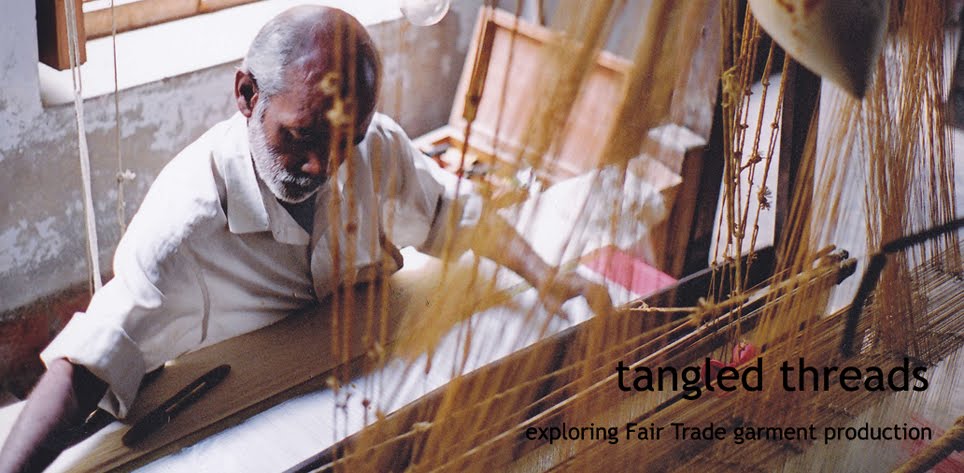.jpg)
.jpg)
.jpg)

16th July
Arduous journey overnight to Cox’s Bazaar despite having the whole back seat to lie on, however this means little if the roads are potholed and your driver is a psychopath. I ended up ‘sleeping’ with my arms braced against the seat in front of me. I woke up with the sun to find that Miki’s sporting two swollen eyes, which are not journey wounds, so we stop at the main town of Cox’s for Miki to see doctor (who happens to be the niece of Dadi the leader of the Rakhin group). She gives him a shot of steroids and advises him to take anti-allergy tablets, Miki is devastated when she suggests it may be an allergy to mango…
Outside the doctors house we saw where the weft yarn is dyed. The yarn is wrapped onto boards, which is then painted with dye in stripes, this creates a multi coloured pattern on the fabric whilst still being a plain weave. It is traditional technique from the Rakhin Group.
Finally we get to see the ocean, it is muddy. Our hotel is great and looks over a really beautiful building site, but there is AC. The weavers of the Rakhin group are based on Moheshkhali Island, right next to Cox’s Bazaar, we need to take a boat to get there. We head off towards the dock in a battery powered rickshaw imported from China. The dock is rickety, and the sun is hot. We step into our motor boat and after 10 minutes of charring in the midday sun we speed off to the Island. It is great to feel a breeze, its like we’re in the Bangladeshi version of Baywatch.
At the other end there are cycle rickshaws waiting to charge a fortune to carry us to the end of the pier, one was so enthusiastic he drove straight over the end. The local fishermen were drying fish along the banks so there was a somewhat pungent aroma in the air. The island seemed to be a lot more chilled out, most of the inhabitants are Buddhist and were originally from Burma.
There are four weavers in this group, none of them are married or have children. I have never seen such a giggly bunch of women – I am surprised they get any work done at all. But they do, and while they are working with Folk (which is about 8 or 9 months out of the year) they earn about 3600 taka per month. They get paid 23 taka per yard they weave – they average about 6 yards per day (they could do 8 or 9 if it wasn’t for the gossip…)
They all enjoy their work very much, but, they are worried that their craft will die out. As there are only four weavers in this group, I was very curious to understand why – they make such beautiful fabric, it seems a shame to make so little. When I asked the women if they were going to train anyone else, they explained that they had already tried, but no one wants to do the hard work of hand-weaving, young people would rather learn how to use a power loom as 100 yards can be made per day on the power loom – therefore they will earn more money (but only if they can find a good employer). So it seems that Ikat woven by hand on this idyllic little fishing island really will come to an end as these women become too old to carry on. So this begs the question, if no one is willing to sustain this tradition, is it a sustainable way of production? I really hope so.
Before we leave, the eldest of the group lead me upstairs to put the mysterious mud they are all sporting onto my face. She has what looks like a slab of rock and a rolling pin – she pours water on to the slab and rubs the rolling pin on this, it begins to form a paste – she then smears it on my face, neck, chest and ears and I instantly feel cooler – as the tiny breeze touches it, it feels like full on AC. What a find!
The speed boat ride back is truly a Baywatch moment as we skip across the waves and get bounced and jostled, I seem to be the only one enjoying it and everyone else looks a little green.
After a shower and a change – we head towards the beach at sunset – what a sight. The beach is heaving with holidaying Bangladeshi’s, all taking photos of each other in the surf. I get photographed too, tip: for those wishing to take a sneaky picture – turn the stupid noises off your phone! We head back to the hotel to sample some of the local rice ‘wine’. An interesting take on the word. It is strong, it is burny and it tastes like homemade rocket fuel – which I suppose it is. We then head for dinner at the Mermaid. What an experience, the tables are all surrounded by water and subsequently mosquitoes and they are pumping out The Black Eyed Peas. The food is good and so is the grape shesha.
y






.jpg)
.jpg)
.jpg)
.jpg)
.jpg)
.jpg)

.jpg)
.jpg)
.jpg)

.jpg)
.jpg)

.jpg)
.jpg)
.jpg)



.jpg)
.jpg)

.jpg)
.jpg)
.jpg)
.jpg)

















